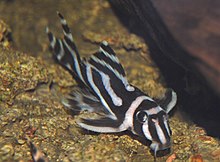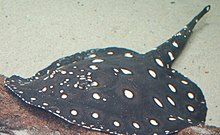Clearwater river (river type)

A clearwater river is classified based on its chemistry, sediments and water colour. Clearwater rivers have a low conductivity, relatively low levels of dissolved solids, typically have a neutral to slightly acidic pH and are very clear with a greenish colour.[2][3][4] Clearwater rivers often have fast-flowing sections.[3]
The main clearwater rivers are South American and have their source in the Brazilian Plateau or the Guiana Shield.[4][5][6] Outside South America the classification is not commonly used, but rivers with clearwater characteristics are found elsewhere.[7]
Amazonian rivers fall into three main categories: clearwater, blackwater and whitewater. This classification system was first proposed by Alfred Russel Wallace in 1853 based on water colour, but the types were more clearly defined according to chemistry and physics by Harald Sioli from the 1950s to the 1980s.[2][8][9] Although many Amazonian rivers fall clearly into one of these categories, others show a mix of characteristics and may vary depending on season and flood levels.[9][10]
Location[edit]

The main clearwater rivers are South American and have their source in the Brazilian Plateau or the Guiana Shield. Examples of clearwater rivers originating in the Brazilian Plateau include Tapajós, Xingu, Tocantins, several large right-bank tributaries of the Madeira (notably Guaporé, Ji-Paraná and Aripuanã) and Paraguay (although heavily influenced by its whitewater tributaries).[4][5][6][11] The Tapajós and Xingu alone account for 6% and 5%, respectively, of the water in the Amazon basin.[12] Examples of clearwater rivers originating in the Guiana Shield include the upper Orinoco (above the inflow of the blackwater Atabapo and whitewater Inírida–Guaviare), Ventuari, Nhamundá, Trombetas, Paru, Araguari and Suriname.[4][5][6][13]
Outside South America the classification is not commonly used, but rivers with clearwater characteristics are found elsewhere, such as the upper Zambezi River, certain upland streams in major river basins of South and Southeast Asia, and many streams of northern Australia.[7]
Chemistry and sediments[edit]

In South America, clearwater rivers typically have their source and flow through regions with sandy soils and crystalline rocks. These are generally ancient, of Precambrian origin, and therefore heavily weathered, allowing relatively few sediments to be dissolved in the water.[2][4] This results in the low conductivity, relatively low levels of dissolved solids and clear colour typical of clearwater rivers.[2]
Sand and kaolinite are the typical sediments transported by clearwater rivers, similar to blackwater, but unlike whitewater that also transports high levels of illite and montmorillonite, resulting in a significantly higher fertility of places influenced by the latter river type.[8] Nevertheless, although clearwater rivers can have extremely low nutrient levels similar to blackwater, some such as the Tapajós, Xingu and Tocantins have nutrient levels that are intermediate between black and whitewater.[8] The exact chemistry of clearwater rivers varies,[8] but it is often very similar to rainwater, low in major nutrients with sodium as the relatively dominating chemical.[14]
The water is typically neutral to slightly acidic,[4][14] but the pH can range between 4.5[8] and 8.[2] In the Amazon basin, clearwater rivers flowing through regions with sediments of Tertiary age are typically highly acidic, while those flowing through sediments of Carboniferous age are closer to neutral or slightly basic.[8]
As suggested by the name, clearwater rivers are highly transparent with a typical visibility of 1.5–4 m (5–13 ft).[15] There can be large variations, even within a single river, depending on season or heavy rains.[8]
| Juruá River (typical whitewater) | Tapajós River (typical clearwater) | Tefé River (typical blackwater) | |
|---|---|---|---|
| pH | 7.27 | 6.56 | 5.03 |
| Electric conductivity (μS/cm) | 191.14 | 14.33 | 7.36 |
| Total suspended solids (mg/L) | 51.42 | 10.56 | 7.90 |
| Ca (mg/L) | 32.55 | 0.52 | 0.71 |
| Mg (mg/L) | 4.42 | 0.26 | 0.22 |
| Na (mg/L) | 10.19 | 1.50 | 0.40 |
| K (mg/L) | 1.98 | 0.93 | 1.41 |
| Total P (mg/L) | 0.080 | 0.010 | 0.033 |
| CO 3 (mg/L) |
106.14 | 8.80 | 6.86 |
| NO 3 (mg/L) |
0.031 | 0.040 | 0.014 |
| NH 4 (mg/L) |
0.062 | 0.19 | 0.13 |
| Total N (mg/L) | 0.39 | 0.35 | 0.24 |
| SO 4 (mg/L) |
2.56 | 0.30 | 4.20 |
| Colour (mg/Pt/L) | 41.61 | 4.02 | 54.90 |
| Si (mg/L) | 5.78 | 5.25 | 0.33 |
| Cl (mg/L) | 4.75 | 0.53 | 0.85 |
Ecology[edit]

The difference in chemistry and visibility between the various black, white and clearwater rivers result in distinct differences in flora and fauna.[2] Although there is considerable overlap in the fauna found in the different river types, there are also many species found only in one of them.[18][19][20] Many blackwater and clearwater species are restricted to relatively small parts of the Amazon, as different blackwater and clearwater systems are separated (and therefore isolated) by large whitewater sections.[2][19] These "barriers" are considered a main force in allopatric speciation in the Amazon basin.[2]

Many species of fish, which often are threatened (especially by dams), are only known from clearwater rivers.[1][2] Large sections with rapids are home to specialized, rheophilic fish,[1][17] as well as aquatic plants such as Podostemaceae.[8][22] There are major differences in the amount of macrophytes and this is mainly related to light: heavily shaded clearwater rivers have few, while those flowing through more open regions often contain many.[8] Clearwater rivers have relatively low productivity compared to whitewater rivers, resulting in a comparably low insect abundance.[4]
References[edit]
- ^ a b c Andrade, M.C.; L.M. Sousa; R.P. Ota; M. Jégu; T. Giarrizzo (2016). "Redescription and Geographical Distribution of the Endangered Fish Ossubtus xinguense Jégu 1992 (Characiformes, Serrasalmidae) with Comments on Conservation of the Rheophilic Fauna of the Xingu River". PLOS ONE. 11 (9): e0161398. Bibcode:2016PLoSO..1161398A. doi:10.1371/journal.pone.0161398. PMC 5035070. PMID 27662358.
- ^ a b c d e f g h i Duncan, W.P.; M.N. Fernandes (2010). "Physicochemical characterization of the white, black, and clearwater rivers of the Amazon Basin and its implications on the distribution of freshwater stingrays (Chondrichthyes, Potamotrygonidae)". PanamJAS. 5 (3): 454–464.
- ^ a b Giovanetti, T.A.; Vriends, M.M. (1991). Discus Fish. Barron's Educational Serie. p. 15. ISBN 0-8120-4669-2.
- ^ a b c d e f g van der Sleen, P.; J.S. Albert, eds. (2017). Field Guide to the Fishes of the Amazon, Orinoco, and Guianas. Princeton University Press. pp. 13–18. ISBN 978-0-691-17074-9.
- ^ a b c Junk, W.J.; Piedade, M.T.F.; Schöngart, J.; Cohn-Haft, M.; Adeney, J.M.; Wittmann, F.A. (2011). "Classification of Major Naturally-Occurring Amazonian Lowland Wetlands". Wetlands. 31 (4): 623–640. doi:10.1007/s13157-011-0190-7. S2CID 36001397.
- ^ a b c Venticinque; Forsberg; Barthem; Petry; Hess; Mercado; Cañas; Montoya; Durigan; Goulding (2016). "An explicit GIS-based river basin framework for aquatic ecosystem conservation in the Amazon". Earth Syst. Sci. Data. 8 (2): 651–661. Bibcode:2016ESSD....8..651V. doi:10.5194/essd-8-651-2016.
- ^ a b Winemiller, K.O.; A.A. Agostinho; É.P. Caramaschi (2008). "Fish Ecology in Tropical Streams". In Dudgeon, D. (ed.). Tropical Stream Ecology. Academic Press. pp. 112–113. ISBN 978-0-12-088449-0.
- ^ a b c d e f g h i Sioli, H., ed. (1984). The Amazon: Limnology and landscape ecology of a mighty tropical river and its basin. pp. 160–161, 219, 276–280, 445, 493–494. ISBN 978-94-009-6544-7.
- ^ a b c Ríos-Villamizar, E.A.; M.T.F. Piedade; J.G. da Costa; J.M. Adeney; J. Junk (2013). "Chemistry of different Amazonian water types for river classification: A preliminary review".
- ^ Goulding, M.; M.L. Carvalho (1982). "Life history and management of the tambaqui (Colossoma macropomum, Characidae): an important Amazonian food fish". Revista Brasileira de Zoologia. 1 (2): 107–133. doi:10.1590/S0101-81751982000200001.
- ^ Blettler, M.C.M; M.L. Amsler; I.E. de Drago; L.A. Espinola; E. Eberle; A. Paira; J.L. Best; D.R. Parsons; E.E. Drago (2007). "The impact of significant input of fine sediment on benthic fauna at tributary junctions: A case study of the Bermejo-Paraguay River confluence, Argentina" (PDF). Ecohydrology. 8 (2): 340–352. doi:10.1002/eco.1511. hdl:11336/31047. S2CID 55234507.
- ^ "Waters". Amazon Waters. Retrieved 10 October 2017.
- ^ Mol, J.H.; B. de Mérona; P.E. Ouboter; S. Sahdew (2007). "The fish fauna of Brokopondo Reservoir, Suriname, during 40 years of impoundment". Neotrop. Ichthyol. 5 (3): 351–368. doi:10.1590/S1679-62252007000300015.
- ^ a b "Clearwater Rivers". Amazon Waters. Retrieved 1 October 2017.
- ^ Goulding, M. (1981). Man and Fisheries on an Amazon Frontier. p. 10. ISBN 978-90-481-8520-7.
- ^ "Habitat". zebrapleco.com. Retrieved 10 October 2017.
- ^ a b Hyland, T.; M.H.S. Perez. "Race against time". Exel Magazine. Retrieved 10 October 2017.
- ^ Saint-Paul, U.; J. Zuanon; M.A. Villacorta Correa; M. García; N.N. Fabré; U. Berger; W.J. Junk (2000). "Fish communities in Central Amazonian white and blackwater floodplains". Environmental Biology of Fishes. 57 (3): 235–250. doi:10.1023/A:1007699130333. S2CID 25361090.
- ^ a b Kullander, S.O. (1986). Cichlid fishes of the Amazon River drainage of Peru. Swedish Museum of Natural History. ISBN 91-86510-04-5.
- ^ Henderson, P.A.; W.G.R. Crampton (1997). "A comparison of fish diversity and abundance between nutrient-rich and nutrient-poor lakes in the Upper Amazon". Journal of Tropical Ecology. 13 (2): 175–198. doi:10.1017/s0266467400010403. S2CID 84919041.
- ^ de Carvalho, M.R. (2016). "Description of two extraordinary new species of freshwater stingrays of the genus Potamotrygon endemic to the rio Tapajós basin, Brazil (Chondrichthyes: Potamotrygonidae), with notes on other Tapajós stingrays". Zootaxa. 4167 (1): 1–63. doi:10.11646/zootaxa.4167.1.1. PMID 27701358.
- ^ Collinson, A.S. (1988). Introduction to World Vegetation (2 ed.). p. 222. ISBN 0-04-581031-1.
